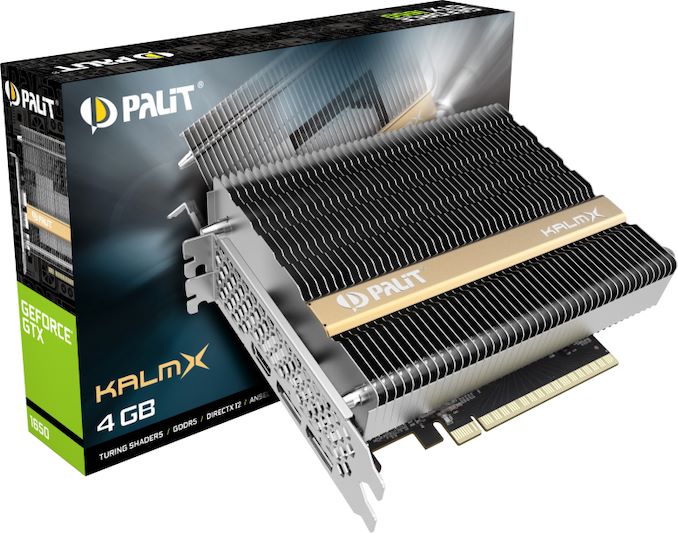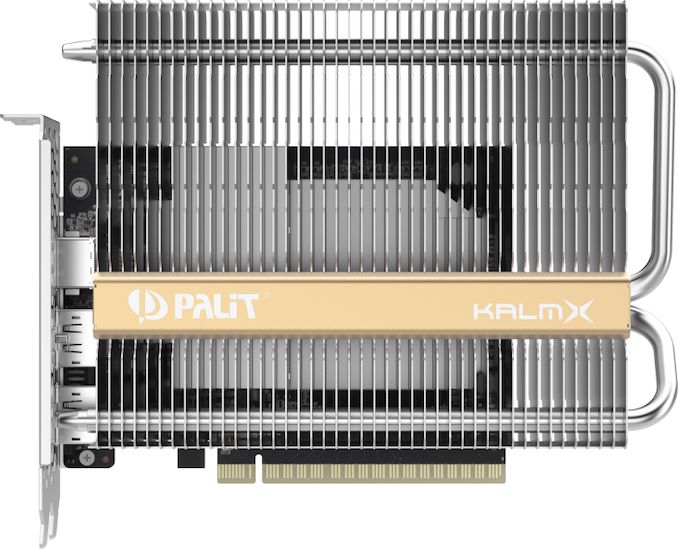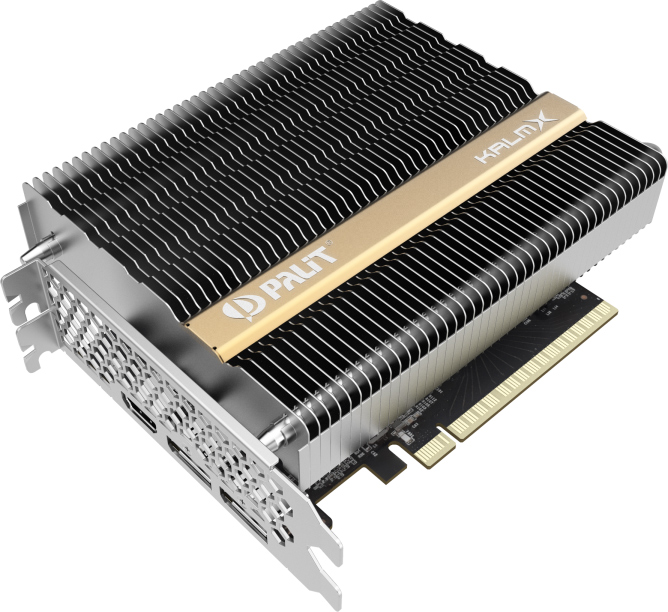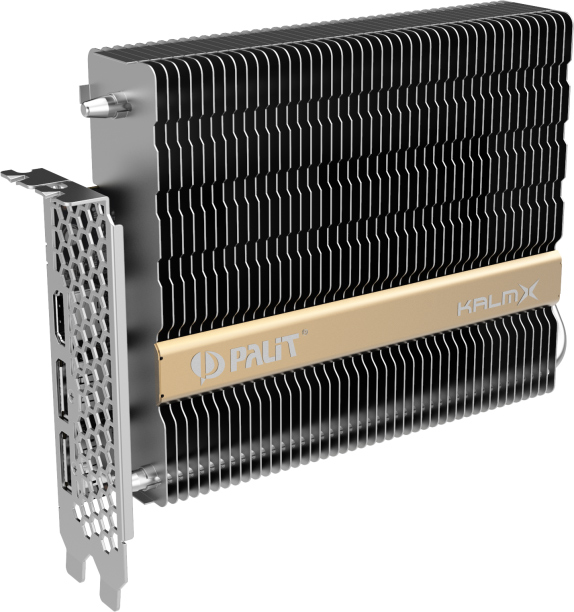A Passively-Cooled GeForce GTX 1650: KalmX by Palit
by Anton Shilov on February 7, 2020 5:00 PM EST
Passively-cooled video cards are rather rare these days, as the bulk of the market has made peace with today's dual fan actively cooled cards. Luckily, there are a still a few companies releasing passive designs, such as Palit Microsystems, who has introduced its fanless GeForce GTX 1650 KalmX.
The Palit GeForce GTX 1650 KalmX (NE5165001BG1-1170H) uses a custom PCB and comes with a sizable passive cooling solution. The double-wide heatsink incorporates a pair of heatpipes, and is considerably taller than the card as well. All told, with the heatsink factored in, the card measures 178 mm long and is 138 mm high. And unsurprisingly, given the strict thermal limitations in play, Palit is playing things conservatively here, and the card runs at NVIDIA official GTX 1650 reference clockspeeds of 1485 MHz/1665 MHz (base/boost).
Typical for GTX 1650 cards, Palit is using 4 GB of 8 Gbps GDDR5 memory here. The card has two DisplayPort 1.4a outputs and one HDMI 2.0b port.
Officially, Palit rates the card for a TDP of 75W; and judging from what we've seen with other GTX 1650 cards, that's probably a bit conservative as well. Which is all the better for Palit, since it makes their job of passively cooling the video card all the easier. The other upside of being a sub-75W card is that an auxiliary PCIe power plug isn't required, so the card can be dropped into a system and immediately used with no further internal wiring.
Palit has not revealed an MSRP for the GeForce GTX 1650 KalmX. NVIDIA’s regular MSRP for the GTX 1650 ($149), though I wouldn't be too surprised to see Palit charge a premium for a unique, passively-cooled card.
Related Reading:
- Palit Announces KalmX: A Passively-Cooled GeForce GTX 1050 Ti Graphics Card
- Akasa's Turing: A Passively-Cooled Chassis for Intel’s Bean Canyon NUC
- Compulab Passively-Cooled Airtop2 Inferno with GeForce GTX 1080
- Calyos NSG Cube: Passively Cooled SFF PC with Intel Core and GeForce GTX 1060
- GALAX Launches Low Profile GeForce GTX 1050 OC and 1050 Ti OC
- GIGABYTE Quietly Launches Low Profile GeForce GTX 1050, 1050 Ti Graphics Cards
- MSI Adds Low-Profile GeForce GTX 1050 Ti to Lineup
Source: Palit













34 Comments
View All Comments
TheWereCat - Friday, February 7, 2020 - link
This would be a neat replacement for the passively cooled GT1030 in my dad's PC.Operandi - Friday, February 7, 2020 - link
These cards are always cool in concept but fail to make practical sense when you take into account you will absolutely need some kind of active cooling in your case to deal with the amount of heat a system with a GTX 1650 will be generating.Still looks like a well made card and maybe it does make sense for the right use cases.
phoenix_rizzen - Friday, February 7, 2020 - link
You can put much larger, slower-spinning (thus quieter) fans into the case, though, compared to the little screamers on GPUs. :)Kangal - Friday, February 7, 2020 - link
Overall efficiency of cooling would be lower.The closer the metal is to the heat-source, and the closer the fans are to the metal/heat-source, the greater the amount of "heat movement" you will achieve. And generally efficiency gets lower as you decrease the size of the fan (even if increasing the quantity). However, there is a limit to where a big fan actually has lower performance.
I'm actually not a fan of liquid-cooling (unless the entire PC is underwater like a Nuclear Reactor). The best solution is actually what is called a "thermosyphon". If the mass-production challenges are accomplished, we might start seeing this anywhere from Home Consoles to Desktop PCs soon.
evernessince - Friday, February 7, 2020 - link
Thermosiphons must be mounted such that vapor rises up and liquid flows down to the boiler, with no bends in the tubing for liquid to pool. Also, the thermosiphon’s fan that cools the gas needs cool air to operate. The system has to be completely airtight; if not, the process of thermosiphon will not take effect and cause the water to only evaporate over a small period of time.MASSAMKULABOX - Saturday, February 8, 2020 - link
Linus tech tips "thermosyphon" .. supposedly quite good , but v v big.FreckledTrout - Monday, February 10, 2020 - link
Normally. There is a company https://www.icegiantcooling.com/ that has a variation of a thermosiphon CPU cooler design that can be mounted 90 degrees offset. Will have to see how well this works out but it so far has done very well in testing.Spunjji - Monday, February 10, 2020 - link
While you're correct that the efficiency (and thus the total amount of heat you can remove effectively) of a setup like that is lower, having a passive card like this in a well-arranged chassis with large, slow-spinning intake fans is still one of the simplest and cheapest ways to achieve near-silent cooling with a moderately capable GPU.inighthawki - Friday, February 7, 2020 - link
These types of cards I think are more typically for specialized scenarios such as ones where reliability is important (no fans = fewer moving parts = more reliable).I also recall a while ago some people on another article had mentioned that in certain settings like industrial environments there is a need for devices where airflow is not practical (e.g. due to very high levels of stuff in the air that eventually destroys long term reliability or corrodes the electronics). Such devices rely on being entirely passively cooled.
Samus - Saturday, February 8, 2020 - link
I’m the one they may have made that comment. In warehouses and factories I almost exclusively use kiosk or other sealed, 100% passive machines (which when paired with an SSD inherently have no moving parts)But the focus is on reliability by managing dust buildup. When factories are on the ocean it has a huge impact on preventing corrosion when they’re on loading docks with the garage doors open to the elements all day.